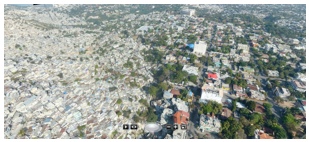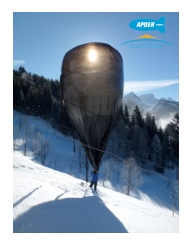 In my work supporting disaster response operations, I have often heard practitioners say, “Where can we quickly get detailed and up-to-date map from?” Chris Hepp, by profession a medical doctor, faced the same issue when deployed on humanitarian and peacekeeping missions with international organizations to Albania, the Kosovo, Rwanda and Haiti. He recognized the value that visual spatial information can add to disaster response and recovery, and he decided to do something about it. Hepp founded Aerial Photos in Disasters Emergencies and Recovery (APDER), a small NGO based in Barcelona, Spain, with the aim to support coordination and planning processes with visual spatial information before, during and after disasters.
In my work supporting disaster response operations, I have often heard practitioners say, “Where can we quickly get detailed and up-to-date map from?” Chris Hepp, by profession a medical doctor, faced the same issue when deployed on humanitarian and peacekeeping missions with international organizations to Albania, the Kosovo, Rwanda and Haiti. He recognized the value that visual spatial information can add to disaster response and recovery, and he decided to do something about it. Hepp founded Aerial Photos in Disasters Emergencies and Recovery (APDER), a small NGO based in Barcelona, Spain, with the aim to support coordination and planning processes with visual spatial information before, during and after disasters.
APDER have developed a unique system for gathering visual information based on a tethered balloon platform on which a robotic camera is mounted: the system can provide high-resolution 2D aerial photographs 30 minutes after the launch of the balloon, and 3D images with links to additional relevant information in less than one hour after the start of the balloon flight. This time aspect is a decisive advantage in a disaster event, not only compared to conventional balloon-based aerial imagery, but also compared to 2D aerial photos obtained from helicopter, aircraft or satellite systems. All APDER image products can be processed with freeware and easily be integrated in open source applications.
The idea of launching a balloon with a camera attached to it to get high-resolution images is not new. Balloons are low-cost carrier systems that are easy to assemble and use and uncomplicated and cheap to maintain. Open community groups and other users have put 2D images obtained from balloon flights to good use for community-based applications. In comparison with drones, balloons are carrier systems that often have a higher acceptance among the beneficiary population in zones of conflict, and face no or only few constraints regarding legal and insurance issues.
 Source: APDERThe APDER equipment consists of a blimp of 3m x 1.5 m x 1.5 m size that is filled with approximately 2.3 m³ helium. The blimp carries a robotic platform on which a camera is mounted. Currently two servomechanisms to control the motion and the position of the camera are in use. One mechanism can be steered directly by using a remote control that enables taking photos and delivering video on demand. A chip that has been programmed to automatically take photos with a certain frequency controls the second mechanism. The blimp itself is tethered on a 250-meter long rope, which results in a maximum operational altitude of 220 – 230 meters. The actual height of the blimp in the air can be changed as needed.
Source: APDERThe APDER equipment consists of a blimp of 3m x 1.5 m x 1.5 m size that is filled with approximately 2.3 m³ helium. The blimp carries a robotic platform on which a camera is mounted. Currently two servomechanisms to control the motion and the position of the camera are in use. One mechanism can be steered directly by using a remote control that enables taking photos and delivering video on demand. A chip that has been programmed to automatically take photos with a certain frequency controls the second mechanism. The blimp itself is tethered on a 250-meter long rope, which results in a maximum operational altitude of 220 – 230 meters. The actual height of the blimp in the air can be changed as needed.
APDER produces 2D aerial photos with a resolution of 7 – 9 cm given this standard setup. Overview Air Panorama Photos (AIR-Panos) can be generated from a series of aerial photos. Sophisticated interactive 3D Spherical Models can be embedded in websites or web portals in a variety of formats (such as the Adobe Flash file format swf, html, html5 or flash VR (Virtual Reality) files), linked to Google Earth and Google maps or visualized on Bing maps. The example below contains a clickable link to such a Spherical Model of an area in Port-au-Prince, Haiti.
Source: APDER
Two or more Spherical Models can be meshed to obtain 3D coverage of large areas, for example entire cities. Adding and linking text-based information referring to specific locations and integrating web links or videos to create a self-standing so-called Spherical Model Information System (SMIS) provides the possibility to enhance the information content that the Spherical Model visualizations offer. A SMIS can be generated, embedded in Microsoft Photosynth (an application that creates 3D models of photos) or integrated in Google applications and viewed in any kind of web browser within a total of 80 minutes after the balloon launch. Similar to the Spherical Models a SMIS can be embedded in websites or combined with Google or Microsoft applications.
Using the standard equipment as described above, the AIR-Panos, Spherical Model and SMIS images (with a resolution of 7 – 15 cm) cover a circle of 3 km radius from the site of the balloon launch – giving a total area coverage of 30 km2. This coverage can be expanded through the use of higher quality equipment by means of mounting a different camera and increasing the operational height of the balloon, or by successive balloon launches at additional sites.
APDER enable practitioners to use the balloon as and when needed. They offer tailor-made training courses for national and international organizations and authorities and for NGOs. The core training is based on modules that provide both theoretical foundations and practical exercises. Issues covered are: the balloon and its handling, cameras and other hardware issues, legal issues, identification of launching locations, etc. Another core part of the training is the use of software for managing the aerial photos. APDER are currently working on an educational program that will make a difference for those users from diverse disciplines who would like to embed an aerial image or photomap into a document or presentation.
APDER also intend to deploy their expert team, the APDER Intervention Team (AIT). The AIT supplies emergency response teams of different organizations with visual information as per specific requirements in an emergency. AIT specialists (from the fields of GIS, remote sensing, urban planning, etc.) are also deployed to support disaster preparedness projects and planning, as well as recovery and reconstruction activities. In these situations AIT experts offer the combination of using aerial photography obtained from the balloon camera with the application-specific integration of the information to enable effective preparedness and recovery operations.
APDER continued to innovate, with Hepp and his team developing a solar-heated (helium-free) balloon, which can be operated at minimal cost in sunny environments. First test flights in the Austrian Alps in March 2013 have been successful. Tests are also carried out with semi-rigid aerodynamic balloons capable of providing stable platforms in windy conditions. All these developments offer the flexibility to meet different user needs in times of disaster.
 Source: APDER
Source: APDER
The APDER system has been successfully applied in a Haiti 2010 Earthquake field mission in collaboration with various humanitarian organizations and partners such as UN Habitat and the International Red Cross. APDER images were provided to urban planners in the recovery phase. The images helped determine the extent of destruction of residential houses, schools and hospitals and were input to reconstruction planning with the local communities in a participatory approach.
Looking back at the disaster response operations, the consensus was that the availability of detailed near-real time information that can be continuously updated is crucial for saving lives in affected areas. Overall, the mission illustrated APDER’s role in facilitating information exchange among a diverse group of users operating in disaster preparedness, response and recovery. The visual information capturing and delivery mechanism APDER provides enables interoperable working procedures that are essential for effective disaster response in affected regions.
For more information about APDER and their services visit www.apder.org or contact Chris Hepp, APDER Chief Executive at chris.hepp at apder.org